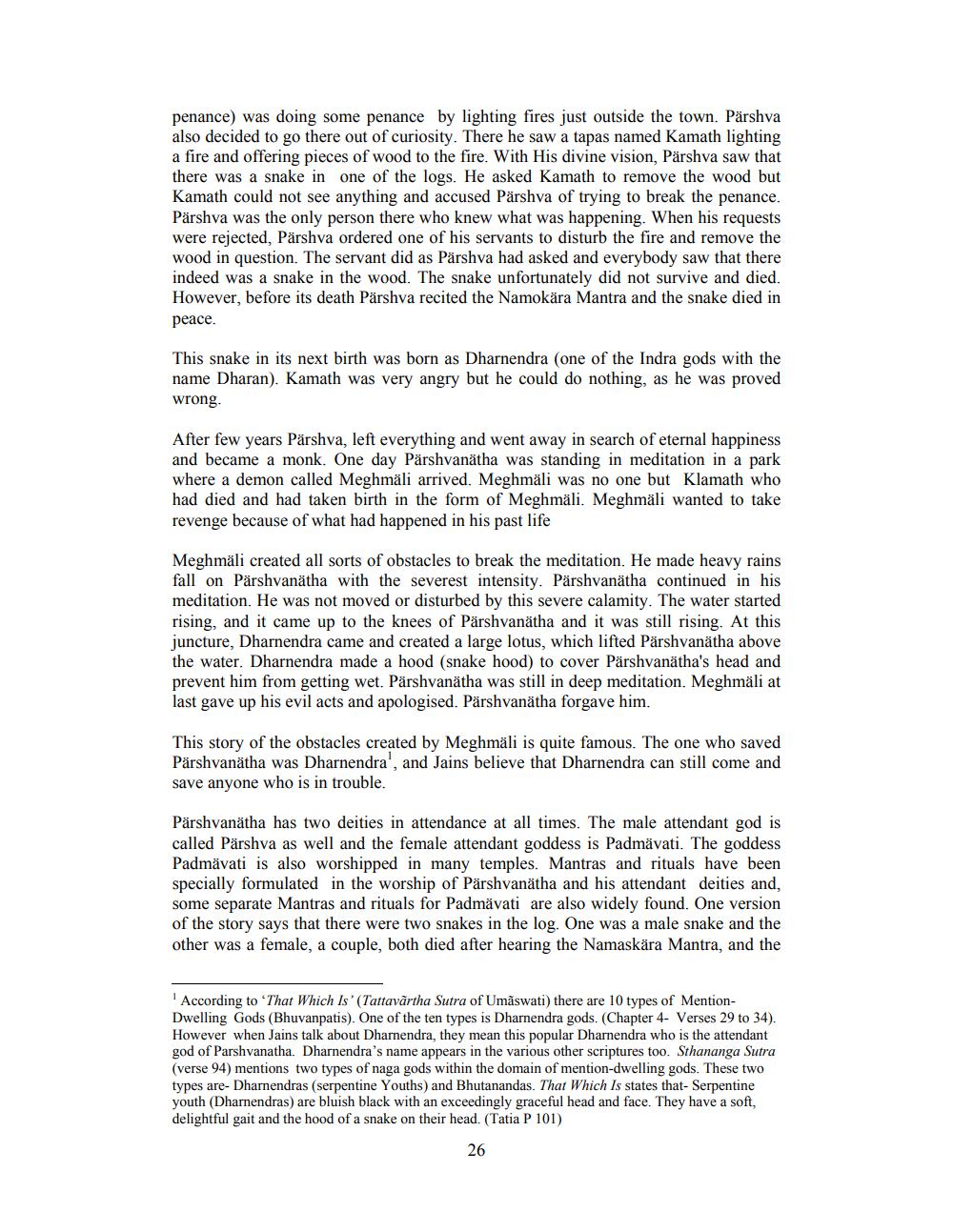________________
penance) was doing some penance by lighting fires just outside the town. Pärshva also decided to go there out of curiosity. There he saw a tapas named Kamath lighting a fire and offering pieces of wood to the fire. With His divine vision, Pärshva saw that there was a snake in one of the logs. He asked Kamath to remove the wood but Kamath could not see anything and accused Pärshva of trying to break the penance. Pärshva was the only person there who knew what was happening. When his requests were rejected. Pärshva ordered one of his servants to disturb the fire and remove the wood in question. The servant did as Pärshva had asked and everybody saw that there indeed was a snake in the wood. The snake unfortunately did not survive and died. However, before its death Pärshva recited the Namokara Mantra and the snake died in peace.
This snake in its next birth was born as Dharnendra (one of the Indra gods with the name Dharan). Kamath was very angry but he could do nothing, as he was proved wrong.
After few years Pärshva, left everything and went away in search of eternal happiness and became a monk. One day Pärshvanatha was standing in meditation in a park where a demon called Meghmäli arrived. Meghmäli was no one but Klamath who had died and had taken birth in the form of Meghmäli. Meghmäli wanted to take revenge because of what had happened in his past life
Meghmäli created all sorts of obstacles to break the meditation. He made heavy rains fall on Pärshvanatha with the severest intensity. Pärshvanatha continued in his meditation. He was not moved or disturbed by this severe calamity. The water started rising, and it came up to the knees of Pärshvanatha and it was still rising. At this juncture, Dharnendra came and created a large lotus, which lifted Pärshvanätha above the water. Dharnendra made a hood (snake hood) to cover Pärshvanatha's head and prevent him from getting wet. Pärshvanatha was still in deep meditation. Meghmäli at last gave up his evil acts and apologised. Pärshvanatha forgave him.
This story of the obstacles created by Meghmäli is quite famous. The one who saved Pärshvanatha was Dharnendra', and Jains believe that Dharnendra can still come and save anyone who is in trouble.
Pärshvanätha has two deities in attendance at all times. The male attendant god is called Pärshva as well and the female attendant goddess is Padmavati. The goddess Padmavati is also worshipped in many temples. Mantras and rituals have been specially formulated in the worship of Pärshvanatha and his attendant deities and some separate Mantras and rituals for Padmavati are also widely found. One version of the story says that there were two snakes in the log. One was a male snake and the other was a female, a couple, both died after hearing the Namaskära Mantra, and the
According to 'That Which Is' (Tattavărtha Sutra of Umaswati) there are 10 types of MentionDwelling Gods (Bhuvanpatis). One of the ten types is Dharnendra gods. (Chapter 4- Verses 29 to 34). However when Jains talk about Dharnendra, they mean this popular Dharnendra who is the attendant god of Parshvanatha. Dharnendra's name appears in the various other scriptures too. Sthananga Sutra (verse 94) mentions two types of naga gods within the domain of mention-dwelling gods. These two types are- Dharnendras (serpentine Youths) and Bhutanandas. That Which Is states that- Serpentine youth (Dharnendras) are bluish black with an exceedingly graceful head and face. They have a soft, delightful gait and the hood of a snake on their head. (Tatia P 101)
26




